#malus sieboldii
Explore tagged Tumblr posts
Text


#pngs#editing#png#transparent#mine#transparent png#malus honanensis#2018#stamps#flowers#china#malus sieboldii#nightmareseditingpngs
43 notes
·
View notes
Text
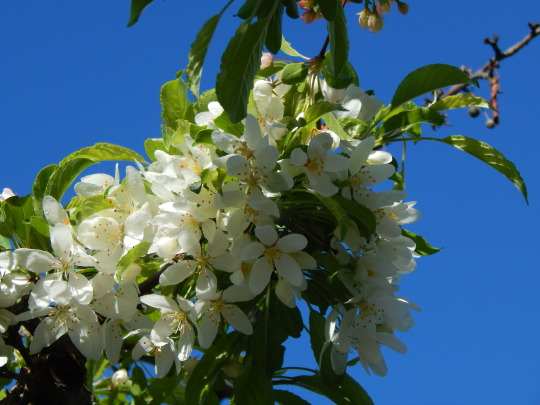
Malus sieboldii
#photographie#photography#photografy#photographers on tumblr#sun#aestethic#france#nature#sky#original photographers#flower#nikkon#spring#malus
20 notes
·
View notes
Text



5/17/2020
Malus sieboldii, or Siebold's crabapple, is native to eastern temperate Asia, in China, Japan, and Korea. (X)
#Malus sieboldii#Siebold's crabapple#crabapple#this adventurous life#personal#adventure#explore#travel#explorer of the world#wisconsin#flower blossoms#tree blossom#fruit tree#fruit trees#flowers#white
4 notes
·
View notes
Text
-Report on the results of paint analysis pt2-
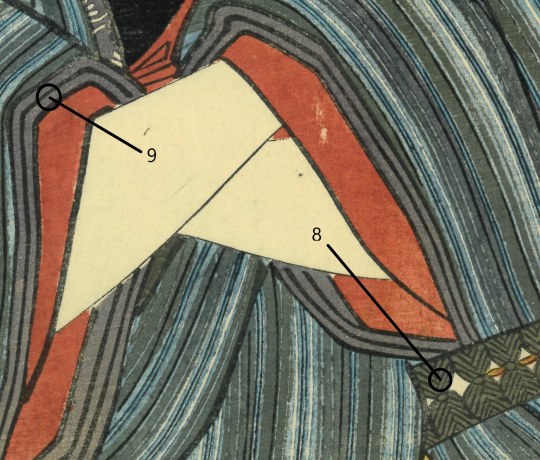
8-[prussian blue + orpiment + rice flour]
The same paint combination as 4, but this one has a yellowish and brownish tint.Regarding the yellowness, it is a matter of the amount of orpiment, but for the brownish one, it was expected that ink and red iron oxide would be mixed in by the first judgment only by the naked eye.But it is not actually detected and the cause is unknown.
In the early Edo period, most orpiments relied mainly on imports from China and Southeast Asian countries, but in the first half of the 18th century, artificial orpiment production was developed in Aizu.It is said that the frequency of use of ukiyo-e will increase after around 1830, so it seems that the market system for supplying cheaply to some extent was established around this time.宇田川溶庵・訳「舎密開宗 巻十四 第二百四十ニ章」1837 describes the Western-style orpiment manufacturing method.And it is written that the color tone of red to yellow can be produced depending on the amount of sulfur and arsenic used as raw materials.Therefore, the origin of the brown color in 7 this time is that there was a red orpiment as a type of orpiment that was on the market at that time. And the first speculation is that it was used. In addition, I do not yet know anything definitive about the aging of orpiment,but, from the comparison with 4, I think it is unlikely that this brown color is due to aging.In old literatures, there are descriptions such as "poor durability and gradually fading" and "it is not affected by air and humidity, but it has the property of fading when exposed to sunlight."The second speculation is the possibility of safflower red contamination for the following reasons.
9-[safflower red or rice flour]
On the Horiba side who requested the analysis this time, Ukiyo-e was the first subject of the survey, and there is a part that could not be determined in this survey.It is the distinction between safflower red, turmeric, blue and aobana paper, and rice flour.(In this regard, even if the original image uses other dyes such as yellowfin and malus sieboldii, it may have been difficult to distinguish between them.)That is why the analysis results of these 9 are safflower or rice flour, and the use of aobana paper can be clearly confirmed with the naked eye.That is why there is a phrase "or" in the results of 13 and 14 below.
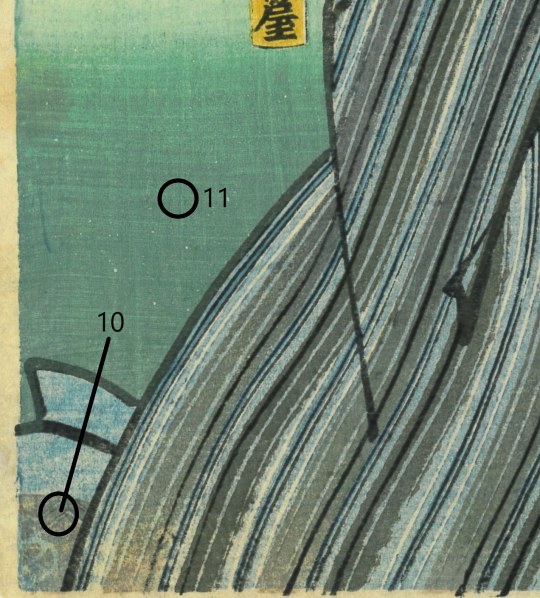
10-[prussian blue + orpiment + rice flour + glue]
This part is printed on the blue (Prussian blue + rice flour) rubbed in the same version as 17.Therefore, it is necessary to keep in mind the possibility that the paint used for the woodblock on which this part is printed is mainly orpiment and glue when making the actual color.Adding glue to orpiment is effective given that orpiment is a relatively coarse-grained powder pigment.However, glue was not detected in places such as 4, 7, 8 and 11 even though one of the orpiments was used.The use of glue is commonplace, as synthetic pigments are common among modern traditional printer.
But as far as I read the literatures written about old ukiyo-e techniques such as 高鋭一「日本製品図説」1877, or 石井研堂「錦絵の彫と摺」1929, the description about the use of glue is very limited.So there is a kind of question about how much it was used in the past, its range and frequency of use.
When I actually analyzed the original paint this time, the suspicion deepened further.
In the future, I would like to proceed with research to clarify the regularity and factors of the use of glue in the original ukiyo-e.
11-[prussian blue + orpiment + turmeric or rice flour]
It seems that the green around this age is generally a combination of Prussian blue + orpiment and also, in terms of necessity, it is unlikely that turmeric was intentionally mixed in to produce color, but , as the number of analysis points of the original picture is increased in the future, it may be possible that the mixture of "turmeric" will become new knowledge about how to make green at this time.
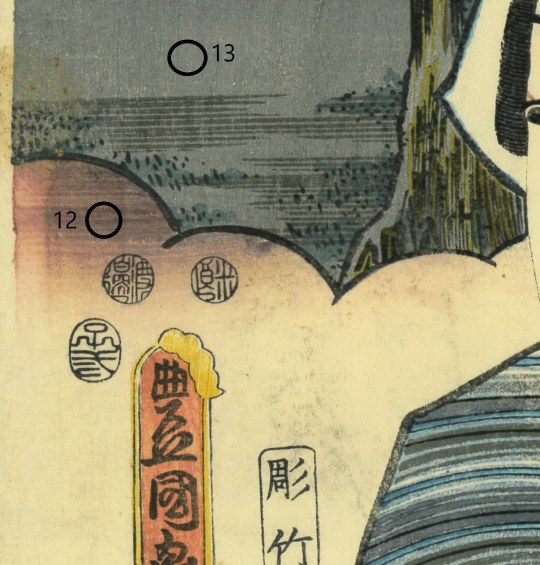
12-[safflower or rice flour]
As with 9, we could not identify it by this analysis, but it seems that the use of aobana paper is correct.
13-[lead white + ink + indigo]
Since Prussian blue was first used in Edo ukiyo-e in 1829, the use of indigo has been very limited.Also, since the bluish tint could not be confirmed with the naked eye from this point, the detection result of the indigo after the analysis was unexpected.
This was not because the printer at that time intentionally used the indigo , but rather because of the problem of cleaning the brushes and paint bowls, which were the tools of the printer at that time.
It may be more correct to think that the paint from the previous work remained in such things.Also, as mentioned above, there is a possibility of problems in analysis judgment.
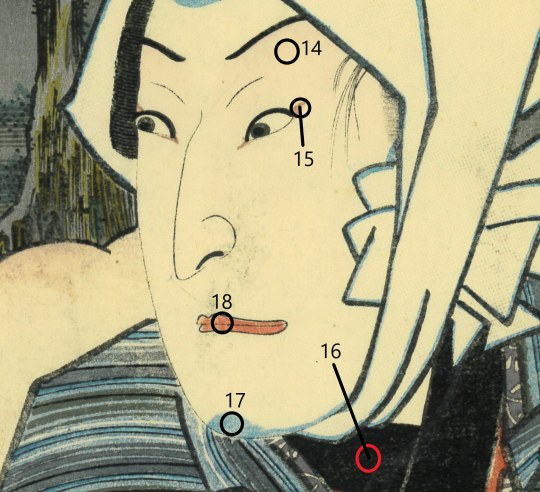
14-[safflower or rice flour]
Reds such as 2 and 18 contain red iron oxide, but 14 does not.
It can be confirmed in the literature that Bengala, mercury vermilion, and lead are mixed in the red when it is made for printing.And also, I was able to actually confirm it in this survey, but in 14, it is only safflower.This is because safflower red was an expensive paint at that time, and in order to reduce its use, Bengala and vermilion were mixed when using it, but it is thought that there was no need for it in light colors such as 14 and It is also possible that there was an idea that only safflower red was used to the eyes gradation as a way of using colors and aesthetics at that time.
15-[bengala + Prussian blue + ink + stone yellow]
Initially, it was speculated that the brownish color of this area might be due to the aging of safflower red but ,in fact, no safflower was detected, and it turned out that it was brown from the beginning when it was printed.If it weren't for this analysis, I would have thought that I would have mixed red flowers and safflower to create a color and aimed for the color before fading, and finished it with a color that was more reddish than the original.Also, the use of prussian blue, sumi, and orpiment was almost impossible to distinguish with the naked eye.
These have a minor effect on the color, and I think that the color was judged to be due to aging.
It seems that the color of the eyes has a large effect on the impression of the picture due to the difference in color, so I could not help but realize the usefulness of scientific analysis of paints.
16-[sumi + rice flour + glue]
In the use of ukiyo-e paints, there are two types of sumi, "pickled sumi" and "glossy sumi".
The former is made by soaking the sumi stick in water and mashing it when the glue that hardens the sumi is soaked, and the latter is made by mashing the melted pieces of sumi stick.In addition, it seems that there was also a case of "especially when printing fine luxury items, use the fine sumi stick with an inkstone" (石井研堂「錦絵の彫と摺」1929) , I don't think all of the printers today do this, but I've heard that Inuki Tachihara was doing it.
The period for soaking the pickled sumi in water is "3 to 4 days and nights" in the above-mentioned "錦絵の彫と摺", but it is "5 to 6 months" in "榊原芳野 編「文芸類纂 巻八」1878".
Regardless of the period of soaking, it seems that glue will remain more or less in both pickled and glossy ink, so the results of this analysis were within expectations.
Also, although it is not seen in the literature, it seems that it has been common sense for a long time to mix glue when using sumi including india ink or non-genuine sumi in modern traditional printers.
However, T. TOKUNO "JAPANESE WOOD-CUTTING"
AND WOOD-CUT PRINTING "1894 says," when using pickled sumi, add glue or rice flour paste, and it is up to the printer to decide which to add. " In addition to this, I have not yet seen the description "adding glue to sumi as printing" in old literature.
Some doubts remain about the actual state of glue addition (the actual state of use of glue) in sumi in ukiyoe in the edo period .
17-[prussian blue + rice flour]
It seems that the color of Prussian blue currently on sale has been improved more beautifully than before (in addition, there are differences in the type itself).
Therefore, I'm a little worried from now on whether the finish will be too bright and clear when I print the color, even considering that it is made after removing aging deterioration.
If I do it in the way of a traditional printer, I can mix other paints appropriately and bring it closer to the desired color, but I do not want to do it as much as possible.
18-[bengala + titanium + safflower or rice flour]
Titanium detection was totally unexpected.Titanium White as a paint containing titanium, but it was developed in the 20th century.What was detected this time is thought to have adhered in some way later, but the actual situation is unknown.
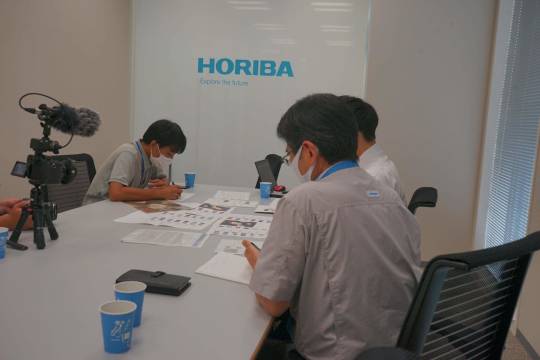
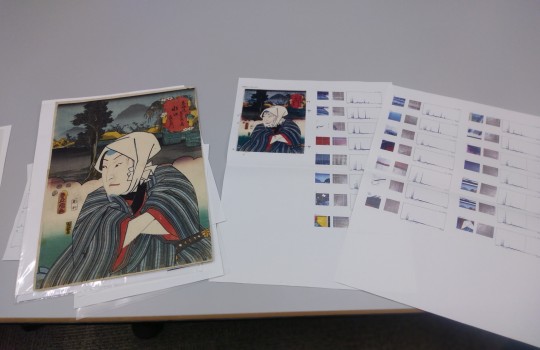
・After the analysis
There are many parts where the actual conditions and properties of the use of ukiyo-e paints in the past have not yet been clarified, in addition, the colors of ukiyo-e are easily affected by aging, and there are also parts where the colors are personally and voluntarily created by the printers of the time.
So, it is often impossible to distinguish the paint used in the current original based only on knowledge, experience, and sense.
Especially this time, I felt the usefulness of scientific analysis, such as "discrimination of the use of lead white" or "discrimination of the color mixture of safflower red and red iron oxide", which are the parts that greatly affects the color of the finished work during restoration.
In addition, "actual conditions of use of glue and rice flour paste", "types of orpiment paints and aging properties", "aged properties of white lead" or "presence of lead sulfate", these things have become even more conscious as my future research theme.
Scientific analysis of original paints is a very effective and meaningful method for restoration and research on ukiyo-e manufacturing methods and paints in the Edo period .I would like to continuously adopt this method, utilize it in the production of works, and proceed with research and elucidation.
(As an aside, there are people who confuse the "reprinted ukiyo-e" made by traditional woodblock printmakers with the "restoration of ukiyo-e".It makes me feel dark when I think that I'm seemed from the world that I'm trying to make the same thing as the traditional reprinted ukiyo-e by the current craftsmen of traditional woodblockprinting, or reprints of used items that are cheaply available at online auctions and second-hand bookstores.
I hope that those who have read this far will understand that "reproduction" made in the traditional woodblockprint industry is different from "restoration".)
Thank you for reading.
Yuuya Shimoi
1 note
·
View note
Text
Malus sieboldii
Le Pommetier de Siebold[6],[7] ou Pommetier toringo[8], de son nom scientifique : Malus sieboldii ou Malus toringo selon les sources, est une espèce de pommiers sauvages, originaire d'Asie (Chine, Japon, Corée). Le pommier Toringo est un petit arbre hermaphrodite à feuilles caduques. Plus d'information https://ift.tt/3esnNWn
0 notes
Photo

Christina and Malus sieboldii in Helsinki, Finland. May 2018.
2 notes
·
View notes
Photo


Malus floribunda, common name Japanese flowering crabapple, Japanese crab, purple chokeberry, or showy crabapple, originates from Japan and East Asia. It may be a wild species, or a hybrid of M. sieboldii x M. baccata.
#malus floribunda#japanese flowering crabapple#purple chokeberry#crabapple#japan#apple trees#herbarium#herbarium specimen#tree branch#blossom#spring flowers#japanese
184 notes
·
View notes
Text
Malus sieboldii Aros takes best in show at HTA National Plant Show
Frank P Matthews' variety Malus sieboldii Aros has been named Best in Show at the HTA National Plant Show's plant awards.
0 notes